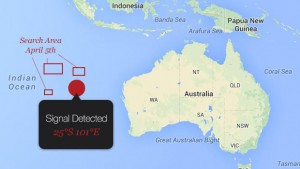Update: Yeah, “noise” is the right description
Frankly, to a non-expert like me, the Chinese equipment doesn’t look like much more than a tin can on a string. And they had a spare pinger in their inflatable boat, which would start pinging if it got wet, and what doesn’t get wet in an inflatable boat, so maybe what they heard was their own damn pinger. There are lots of transient noises in press conferences, too, on all frequencies and most of them sound like CYA. That’s what people do when they keep coming up empty-handed.
Update: More noises?
The sounds reported on Friday came from a hand-held sonar device held over the side of a small tender accompanying the Chinese patrol boat. Although this is possible, the limited nature – something experts said was technically possible — evokes caution. However, there have now been two additional reports that could be the missing plane. The sounds are not all from the same area and experts are concerned that no one has yet gotten the continuous pinging that should come from a black box.
Nonetheless, retired Australian Air Chief Marshall Angus Houston, who is coordinating the search, said. “This is an important and encouraging lead, but one which I urge you to treat carefully,” “What we’ve got here are fleeting, fleeting acoustic events. … That’s all we’ve got,” “It’s not a continuous transmission. If you get close to the device, we should be receiving it for a longer period of time than just a fleeting encounter.” “We are dealing with very deep water, we are dealing with an environment where sometimes you can get false indications,”
“There are lots of noises in the ocean, and sometimes the acoustic equipment can rebound, echo if you like.”
The first ships with sophisticated sound-locating equipment is expected to arrive early Monday, Houston said.
The crew of the Chinese ship reportedly picked up the signals using a hand-held sonar device called a hydrophone dangled over the side of a small runabout – something experts said was technically possible but extremely unlikely.
The equipment aboard the Ocean Shield and the HMS Echo are dragged slowly behind each ship over long distances and are considered far more sophisticated than those the Chinese crew was using.
Houston also said that a refinement of the analysis of satellite data was pointing to the section of the current search zone where the signals were found.
Update: The same Chinese ship reported detecting the signal again on Saturday, within 1.4 miles of the original location. The Australian head of the international search effort called the development “an important and encouraging lead, but one which I urge you to treat carefully.” Meanwhile, an Australian ship is investigating another acoustic signal in a different area.
China’s state media claimed Saturday a Chinese ship equipped with a black box detector reported hearing pings at the same frequency and intervals used by aircraft black boxes, and a Chinese plane allegedly spotted floating objects 56 miles away, on Friday. The location, between the main search area and the Australian coast, and at about the same latitude, is a plausible potential crash site. But other searchers are skeptical of the Chinese reports.
The search has produced many false leads and disappointments, and the Chinese have been wrong before. They haven’t cooperated with the international search effort, and their search teams route their communications through Beijing instead of reporting to search headquarters in Perth, which enables Beijing to filter and manipulate information releases to the public.
The Chinese ship with the pinger gear did not answer radio calls from other search ships and planes seeking details of the Chinese finds, but Chinese state TV showed a video of three men in a rubber dinghy lowering a hydrophone into the water with a pole.
Australian search coordinators are debating whether to commit search resources to the area.
Oceans are full of natural noise, but black box pingers are designed to make a unique sound on a specific frequency. However, a black box ping can be confused with nuclear submarine noise, and at least one sub is nearby. Also, a crash site should give off two pings, and the pinging should be continuous. But the missing plane’s black box batteries were expected to expire this weekend, and it’s conceivable one of the pingers had already quit and the other died just as the ship detected it — which would make it a lucky find indeed.
If the pings were from the missing plane, its wreckage would be inside an area of about four square miles, given the pinger’s limited range. Even if the pingers are no longer working, sonar could pinpoint the wreckage, but it takes some time. We’ll just have to wait and see if this amounts to anything. So far, there’s no evidence that searchers have correctly guessed the plane’s flight path. The missing plane could be almost anywhere within the radius of its fuel range. 